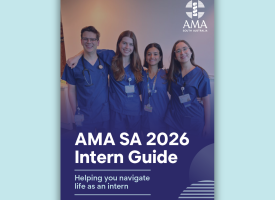AMA submission takes strong stance on the role of Nurse Practitioners
AMA Council of General Practice, Chair, Dr Richard Kidd, comments on the draft Nurse Practitioner 10 Year Plan consultation paper below.

The AMA is finalising its submission in response, which will be available to view on the AMA website next week.
We all know that nurse practitioners (NPs) can be a valuable member of a collaborative and multidisciplinary health care team. However, there is no substitute for the care provided by a general practitioner (GP).
The Government has released a draft Nurse Practitioner 10 Year Plan consultation paper. While it is important that we encourage and support the development of the nursing workforce and maximise their opportunities to contribute to the delivery of health care, we know that this needs to be part of team based approach to care. Otherwise, we risk fragmentation and the risks that brings, both for patients and the overall functioning the health system.
The AMA has lodged a robust response to this consultation paper, highlighting that the training and experience of nurse practitioners is very different to GPs. While nurse practitioners offer advanced skills in specific areas of practice, only GPs are trained to provide comprehensive first contact, holistic and continuing care for patients with any undiagnosed sign, symptom, or health concern. The discussion paper fails to acknowledge this important distinction and tends to overstate the potential scope of practice of a nurse practitioner.
As a colleague recently said in response to this issue, the risks in having the skills for making a limited diagnosis of specific illness or injury is that “you don’t know what you don’t know”.
The nurse practitioner model has been developed within a supportive environment where there is strong emphasis on collaboration and access to medical support where necessary – often in a public hospital or community health service or sometimes in a private medical practice. Some time back, a limited range of MBS items were established for nurse practitioners but these were contingent on a collaborative agreement being in place with a doctor. These checks and balances ensure that they have autonomy but not independence. It’s a framework for safe patient care where everyone works together and not in isolation. In responding to the consultation paper, we have emphasised that the consequence of undermining the collaborative model is that care invariably will be fragmented. This will, increase the risk of poor patient outcomes due to misdiagnosis and missed diagnosis, delayed medical intervention and treatment, and adverse outcomes from the interaction of different medications and treatments.
There will be also more costs as a result of the duplication of services as well as the unnecessary requesting of imaging and pathology services and provision of needless referrals. While most nurse practitioners work in the public health system and seem to value the supportive environment that it provides, there are some who argue that the collaborative arrangements required to access the MBS rebates are a barrier to the expansion of the NP workforce. The evidence suggests otherwise with nurse practitioner numbers steadily increasing year on year.
What problem are nurse practitioners who want to move outside the collaborative model trying to fix?
While nurse practitioners are sometimes promoted as a means to address workforce shortages and improve access to care, this is best achieved when they are part of a well-coordinated GP led model of care. With Australia having now decided to embrace the medical home, policy must be directed towards further strengthening General Practice and supporting GPs to collaborate with other health care professionals, like nurse practitioners, in circumstances where the care of the patient would benefit from this.
Any policy direction that seeks to support nurse practitioners in carving out a more independent role in the health system is the antithesis of the move towards the medical home and the benefits to the health system that this will bring.
There is no doubt that the needs of our patients are becoming more complex and GPs have responded by changing the way we deliver and organise care. It is fantastic when we can bring other health care providers into the team so that we can achieve better health care outcomes for our patients. Our role is to make sure the patient gets the right diagnosis and the right care from the right health care professional.
Coordination of this care is key and, while I am happy to see nurse practitioners play a greater role in a GP led team, our patients and the health system cannot afford a new independent nurse practitioner model. Our GP led model has stood the test of time and is admired throughout the world and with the introduction of permanent telehealth and growing GP numbers, continues to remain highly accessible.



